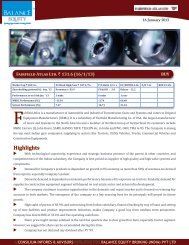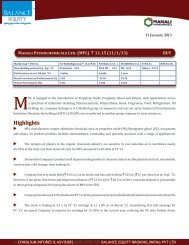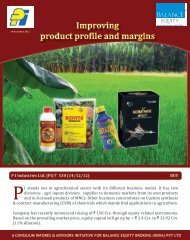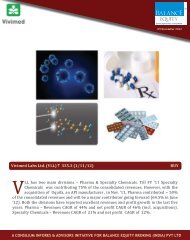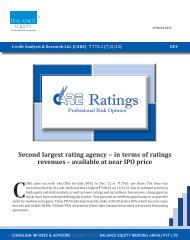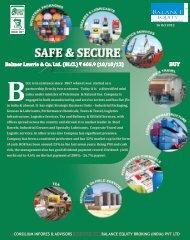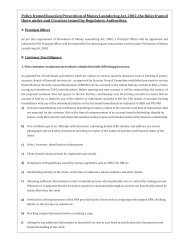Liberty Phosphate Ltd.
Liberty Phosphate Ltd.
Liberty Phosphate Ltd.
Create successful ePaper yourself
Turn your PDF publications into a flip-book with our unique Google optimized e-Paper software.
<strong>Liberty</strong> <strong>Phosphate</strong> <strong>Ltd</strong>.TMHighlightsBSE SENSEX/S & P NIFTY 17560.87/5322.95SectorFertilizersMarket Cap./Free Float (` Crs.) 103/46Market Price as on 09/08/12 ` (FV `10/-) 71.6052 Week High/Low ` 97.50/45Equity Shares Outstanding (in Crs.) 1.44P/E Ratio (Times) (for FY ‘12) 1.8P/B (Times) (for FY '12) 0.8EV/EBITDA (Times) (FY ‘12) 1.4ROE % (FY ‘12) 41.6Shareholding Pattern as onJune ‘12 (%)Share Price Performanceu SSP is considered to be poor farmer’s fertilizer as it ischeaper to Di Ammonium <strong>Phosphate</strong> (DAP) in terms of nutrientsand provides an option to optimize use of phosphatic fertilizers.It fulfills the higher requirements of sulphur & phosphate inseveral crops such as oilseeds, pulses, sugarcane, tea, fruits &vegetables etc.u Government wants to encourage use of SSP as it isentirely produced in domestic sector to reduce dependence onimports of potassic-phosphatic (P&K) fertilizers.u Nutrient Based Subsidy (NBS) policy is a long termpositive for fertilizer industry with free market mechanism.u Company has comfortable debt position of 0.53 x. Netdebt is negligible with ` 65 Crs. of cash & cash equivalents. Cashforms about 60% of market cap of the Company.u Prices of Rock phosphate, the main raw material, havegone up by about 50% in FY ’12. This combined with lowersubsidy in FY ’13 and poor monsoon conditions does not augurtoo well for SSP manufacturers.u Delay in subsidy payment, uncertainty of monsoon,volatile international market of raw material, seasonalconsumption of fertilizer (2 months per year), logisticsavailability and cost and high requirements of working capitalshall remain the concern for the industry.u Fertilizer stocks have reacted to the drought like situationin many parts of the country. We believe that it is good time toaccumulate goods stocks in the sector for decent returns over aperiod of one year.<strong>Liberty</strong> <strong>Phosphate</strong> <strong>Ltd</strong>. is also available on www.balance-equity.co.in
<strong>Liberty</strong> <strong>Phosphate</strong> <strong>Ltd</strong>.TMBackground<strong>Liberty</strong> <strong>Phosphate</strong> <strong>Ltd</strong>. is the largest producer and supplier of SSP (Powder & Granulated) in India. It plans to boost its SSPproduction capacity from 5,62,000 MTPA to 924000 MTPA. Apart from SSP it also manufactures NPK Mix Fertilizers & MagnesiumSulphate. It also trades in some fertilizer raw materials & finished products like Rock <strong>Phosphate</strong>, DAP, Urea, Muriate of Potash (MOP),Triple Super <strong>Phosphate</strong> (TSP), Mono Ammonium <strong>Phosphate</strong> (MAP), Water soluble specialty fertilizers and sulphate of Potash.The Company has six manufacturing units situated at Udaipur & Kota in Rajasthan, Nandesari in Gujarat, Pali in Maharashtra,Nimrani in MP and Hospet in Karnataka. Multiple locations of plants allow Company to service demand speedily.Company is planning to set up 1,32,000 MTPA SSP plant at Rae Bareilly in the State of Uttar Pradesh, where Plant & Machineryis under erection, and commercial production is likely to commence sometime in FY ’13 to cater to the demand of North and East India.Company recently completed capacity expansion at its Nandesari unit from 1,00,000 MTPA to 1,98,000 MTPA. It has applied for capacityexpansion at Kota from 1,32,000 MTPA to 1,98,000 MTPA. It plans to expand capacity at Pali from 66,000 MTPA to 1,32,000 MTPA.The Company’s brand of Agri Inputs “DOUBLE HORSE” is well accepted in the market as premium quality product. It is inadvanced stage of talks with other manufacturers to roll out newer products so as to have a larger basket of offerings to its customers.LPL has one 100% subsidiary called <strong>Liberty</strong> Pesticides & Fertilizers <strong>Ltd</strong>. Subsidiary has very small operations with revenuesof ` 0.24 Crs. in FY ’12.The raw material required for manufacturing process of SSP are Rock <strong>Phosphate</strong> & Sulphuric Acid. Indigenous rock phosphateis available in plenty from Jhamarkotra mines, Udaipur. Sulphuric Acid is supplied by Hindustan Zinc <strong>Ltd</strong>. situated at Udaipur. Presentlythe company purchases about 10000 MT per month of Sulphuric Acid for its various units by way of Long Term Agreement withHindustan Zinc <strong>Ltd</strong>. It is also planning to enter in to an agreement for supply of Sulphuric Acid, for its new projects at fixed price for aminimum period of 3 years.The Company plans to set up more units in other States like Haryana, Central Madhya Pradesh and Andhra Pradesh andincrease its production capacity to One Million MTPA.Existing & Proposed Capacity (in MTPA)Plant LocationExistingCapaictyAdditionsTotal CapacityNandesari - Gujarat 100000 98000 198000Kota - Rajastan 132000 66000 198000Udaipur - Rajastan 264000 0 264000Pali - Maharashtra 66000 66000 132000Raie Bareilly - UP 0 132000 132000Total 562000 362000 924000<strong>Liberty</strong> <strong>Phosphate</strong> <strong>Ltd</strong>. is also available on www.balance-equity.co.in
<strong>Liberty</strong> <strong>Phosphate</strong> <strong>Ltd</strong>.TMGovernment regulations/subsidyThe Ministry of Chemicals and Fertilizers approved the NBS in March 2010, in an effort to decontrol prices, moving away fromregulated returns in complex fertilizers to import parity realizations. Since the announcement, fertilizer sales volumes have risensignificantly. For example, in FY11, sales of complex fertilizers other than DAP rose by ~40% despite a significant increase in prices.Under the new regime, there is a fixed subsidy for nutrients and unlike in the past, when the government set the MRP, the currentregime lets manufacturers determine their own selling prices. MRP is expected to fluctuate depending on price variations in fertilizers& raw materials in international markets.Finance Act, 2012 has given stimulus to the fertilizer industry. The government announced that investment linked deductionof capital expenditure incurred, is proposed to be provided at an enhanced rate of 150% as against 100% at present for fertilizers. Ithas exempted 5% customs duty on import of equipment for initial setting up or substantial expansion of fertilizer projects for a periodof three years. This move should encourage new entrants and expansion of capacity by existing players. The focus would now be toencourage the use of SSP more, because, subsidy on SSP is easy to control and product is good for the crops as well. Basic customs dutyon a few soluble fertilizers and liquid fertilizers, other than urea, has been reduced from 7.5% to 5% and from 5% to 2.5% respectively.On 29th March ’12 the Government announced the revised nutrient subsidy rates applicable for FY13. Nutrient subsidieshave declined substantially as compared to FY ’12, with the largest decline in Phosphorus mainly to reduce subsidy outgo in line withdeclining raw material prices. Urea still remains the cheapest fertilizer and hence overused by Indian farmers impacting soil quality.Subsidy on SSP (0-16-0-11) has been fixed at ` 3673 per MT.In order to ensure quality of SSP, the SSP manufacturers are required to produce a certificate of quality issued by the StateGovernments in which the units are located. The units are required to write/print “Quality Certified” on each bag of the SSP. Only thoseSSP manufacturers are allowed to claim subsidy, which produce 50% of the annual installed capacity or 40,000 MTs per annum. TheSSP units are allowed to claim 85% ‘On Account’ payment of concession to be settled subsequently by Department Of Fertilizers (DOF)based on the certification of sales issued by the State Governments. In addition to subsidy per kilo of NBS for <strong>Phosphate</strong> and Sulphurin the SSP, a lumpsum freight subsidy is also allowed. As per latest reports freight subsidy is discontinued.Government is considering change in the method of computation of subsidy on P&K fertilizers grades having less than 85%water soluble P2O5 content.Nutrient based Subsidy - ` per kg. of NutrientNutrients/Year (`) FY '13 FY '12 % changeNitrogen 24 27.2 -11.8Phophorus 21.8 32.3 -32.5Potassium 24 26.8 -10.4Sulphur 1.677 1.7 -1.4<strong>Liberty</strong> <strong>Phosphate</strong> <strong>Ltd</strong>. is also available on www.balance-equity.co.in
<strong>Liberty</strong> <strong>Phosphate</strong> <strong>Ltd</strong>.TMFinancialsCompany’s profitability for FY ’12 improved due to cost control & higher capacity utilization resulting in operating leverage.However, Receivables days of the Company doubled to 125 days in FY ’12 from about 63 days in FY ’11.During the year under review, Company achieved production of 4,83,053 MT of SSP, NPK Mixed Fertilizers and MagnesiumSulphate as against 3,86,016 MT in the previous year, recording growth of 25.14%.Out of the total raw material consumption of ` 254 Crs. for FY ’12, 36% was imported . Rock <strong>Phosphate</strong> (74%) and Sulphuric acid(23.5%) constitutes 97-98% of raw material requirements.Company has 8% Red. Cum. Preference shares of ` 5 Crs. issued in FY ’08. The preference shares are redeemable in five installmentsfrom sixth year from date of allotment.Revenue DistributionFY ‘12 (%)<strong>Liberty</strong> <strong>Phosphate</strong> <strong>Ltd</strong>. is also available on www.balance-equity.co.in
<strong>Liberty</strong> <strong>Phosphate</strong> <strong>Ltd</strong>.TMFinancialsPeriod Ended (` Crs.) FY '10 FY '11 June '11 Sept. '11 Dec. '11 March '12 FY '12Net Sales 210.11 365.14 105.37 110.39 108.56 149.57 487.75(Inc.)/Dec. in stock & WIP -56.48 34.88 12.51 6.16 -14.71 -0.59 6.94Raw Materials 159.76 177.22 49.56 59 67.71 89.61 253.53Purchase of Traded Goods 42.76 18.44 3.81 1.19 8.75 2.57 15.55Employee Cost 8.02 12.39 3.24 3.84 4.12 4.11 16.08Selling & Dist. Exp. 23.8 37.31 11.35 14.4 9.27 22.16 60.45Other Exp. 17.05 23.35 6.29 7.03 6.32 7.23 41.41Total Expenditure 194.91 303.59 86.76 91.62 81.46 125.09 393.96EBITDA 15.2 61.55 18.61 18.77 27.1 24.48 93.79EBITDA Margin (%) 7.2 16.9 17.7 17.0 25.0 16.4 19.2Depreciation 2.28 2.81 0.85 0.47 0.68 0.93 2.9Interest 4.78 6.97 3.06 1.84 3.01 2.27 8.88Taxation 3.64 19.24 4.75 5.13 6.04 8.03 26.49Other Income 0 0.06 0.03 0 1.89 1.92Non Recurring items 0.93 -0.38Forex Loss/(Gain) 0 -2.45 0 0.7 4.79 -1.75 3.52Net Profit 4.5 33.52 9.95 11.36 17.37 15.14 57.06Net Profit Margin (%) 2.1 9.2 9.4 10.3 16.0 10.1 11.7Equity Capital (FV ` 10/-) 14.44 14.44 14.44 14.44 14.44 14.44 14.44Equity Shares (in Crs.) 1.4 1.4 1.4 1.4 1.4 1.4 1.4Reserves 40.98 72.28 122.65EPS (`) 3.12 23.21 6.89 7.87 12.03 10.48 39.52Book Value (`) 38.4 60.1 94.9ROE (%) 8.1 38.7 41.6Note:1. Profits are calculated without considering prior period adjustments & forex gain/loss.2.Dept. of Fertilisers issued two circulars in July & Oct. ‘11 with regard to recognition of subsidy income on opening inventories as on 1/4/11/. Industry playersbased on legal opinion have not considered the impact, which if considered, would reduce sales & net profit of FY ‘12 by ` 10.56 Crs. & ` 7.14 Crs. respectively.<strong>Liberty</strong> <strong>Phosphate</strong> <strong>Ltd</strong>. is also available on www.balance-equity.co.in
<strong>Liberty</strong> <strong>Phosphate</strong> <strong>Ltd</strong>.TMIndustryThere are about 139 fertilizer plants in the country, out of which 80 plants produce SSP with installed capacity of ~ 79 lacs MT.Consumption of SSP in the country is estimated to be about 30 lacs MT. SSP contributes to 6.6% of total phosphatic inputs in India.As per data released by International Fertilizer Association in 2007, there is high correlation between yield per hectare of cereals,paddy and pulses and use of SSP.India is the third largest producer and consumer of fertilizers in the world. Fertilizer consumption increased from 20.3 MTPAin FY ‘06 to ~29.2 MTPA in FY ‘11 led by a rise in phosphorous consumption, which rose from ~5.2 MTPA in FY ‘06 to ~9.4 MTPA inFY ‘11. The consumption growth in FY ’12 was 7% as against 14% in FY ’11. Fertilizer demand is expected to rise at a CAGR of ~8%to ~40-45 MTPA in FY ‘16. Phosphorous is expected to account for a bulk of that increase at a CAGR of ~15% to ~16-18 MTPA inFY ‘16 ,following increased availability of complex fertilizers after the Nutrient Based Scheme (NBS) came into effect. Producers arenow given a subsidy on the volume of nutrient sold as opposed to that on the volume of product sold earlier. This gives the producersincentive to sell other fertilizers besides urea and DAP. Fertilizer consumption per tonne of grain production has increased over theyears.SSP is a chemical Fertilizer which contains Phosphorus as a major plant nutrient. It is relatively very cheap and contains manymicro nutrients like Calcium, Magnesium, Iron, Aluminum, Sulphur and Gypsum. The Gypsum works as a soil conditioner. The SSP ismanufactured by the reaction of finely grounded Rock <strong>Phosphate</strong> with diluted Sulfuric Acid. Manufacturing of SSP is based on perhapsthe simplest chemical reaction amongst chemical fertilizer industry. SSP is a straight phosphatic multi-nutrient fertilizer whichcontains 16% water soluble Phosphorus Penta Oxide (P2O5), 12% sulphur, 21% calcium and some other essential micro nutrientsin small proportions. The Rock phosphate is available in Jordan, Egypt, India, China, Israel, Morocco, Syria, Senegal and many otherAfrican countries. The Sulfuric Acid is produced by using Sulphur as raw material.SSP is cost effective fertilizer, for small & marginal farmers as it provides phosphorous and sulphur at lower cost. Majorportion – about 40% - of agricultural land in India is Sulphur deficient, and it adversely affects the crop yield. N, P, K & S in proper ratioincreases fertility of soil. SSP fertilizer contains Sulphur and Calcium besides Phosphorus, so it is an ideal manure to eliminate sulphurdeficiency of soil resulting into increase in yield of pulses, groundnut etc. to a great extent.NBS policy announced in May ’10 recognized SSP as key fertilizer as NBS brought the price parity to the farmers for P&Kfertilizers based on nutrient content. It also enabled a level playing field for all fertilizers based on nutrient content. As the P componentis also offered by both DAP & SSP, the consumption of SSP increased due to price advantage. Production of SSP was almost stagnantduring last decade. Positive policy change has resulted in higher production and capacity utilization.The SSP is available in powder and granulated form. The Powder form is called as PSSP and the granulated form is calledas GSSP. The PSSP and GSSP are available in two grades. Grade A and grade B. The grading is done on the basis of water solubleP2O5 present in the product. The A grade contains 16% water soluble P2O5 and the B grade contains 14% water soluble P2O5. Thegranulated Super phosphate is some what costlier in comparison to PSSP because of the cost of granulation. The GSSP dissolves slowlyin the water present in the soil so it is available to the crops for a longer time. The free Phosphoric acid present in the SSP is very usefulfor alkaline soils. The PSSP & GSSP are white, cream, gray, brown or black in colour and packed in 50 kg. bags.<strong>Liberty</strong> <strong>Phosphate</strong> <strong>Ltd</strong>. is also available on www.balance-equity.co.in
<strong>Liberty</strong> <strong>Phosphate</strong> <strong>Ltd</strong>.TMUnder the use of new method of sowing, seeds and granular fertilizers are used at the time of sowing only. This has resultedinto shifting of fertilizer demand from powder to granular fertilizers. In view of this, LPL has enhanced production capacity ofGranulated SSP from 2,47,500 MT/annum to 3,30,000 MT/annum during FY ’12.In various crops, which require more of sulphur and phosphate like oilseeds, pulses, sugarcane, fruits and vegetables, tea etc,SSP is an essential fertilizer.Advantages of using SSP1. Provides 15% of total phosphate requirements of the country.2. Lowest price per kg, preferred by small and marginal farmers.3. Multi-nutrient fertilizer containing P2O5 as primary nutrient and Sulphur and Calcium as secondary nutrients.4. It is the cheapest source of Sulphur for the soil.5. Only phosphatic fertilizer which can utilize Indian rock phosphate deposits.6. Least foreign exchange per unit of P2O5.7. Utilizes acid effluent from other chemical industry and thus reduces nation’s cost of effluent disposal.• • • • • • • • • •<strong>Liberty</strong> <strong>Phosphate</strong> <strong>Ltd</strong>. is also available on www.balance-equity.co.in



